Cause of death Falling Role Painter Name H. Giger | Website hrgiger.com Nationality Swiss | |
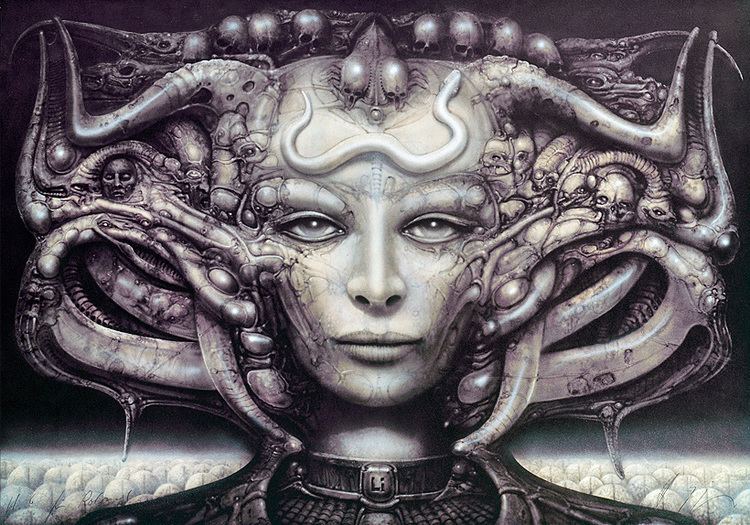 | ||
Full Name Hans Rudolf Giger Occupation Painter, sculptor, set designer, film director Died May 12, 2014, Zurich, Switzerland Artwork Penis Landscape, Biomechanoiden Spouse Carmen Maria Scheifele Giger (m. 2006–2014), Mia Bonzanigo (m. 1979–1982) Influenced by Salvador Dali, H. P. Lovecraft, Alfred Kubin Similar People Li Tobler, Ridley Scott, H P Lovecraft, Salvador Dali, Dan O'Bannon | ||
H r giger signs alien mask 4 charity prometheus world premiere london
Hans Ruedi "H.R." Giger ( ; [ˈɡiːɡər]; 5 February 1940 – 12 May 2014) was a Swiss painter, whose style was adapted for many forms of media, including record albums, furniture and tattoos.
Contents
- H r giger signs alien mask 4 charity prometheus world premiere london
- Bob Ross Special Guest H R Giger
- Early life
- Career
- Personal life
- Death
- Recognition
- Style
- Other works
- Films
- Work for recording artists
- Interior decoration
- Video games
- References
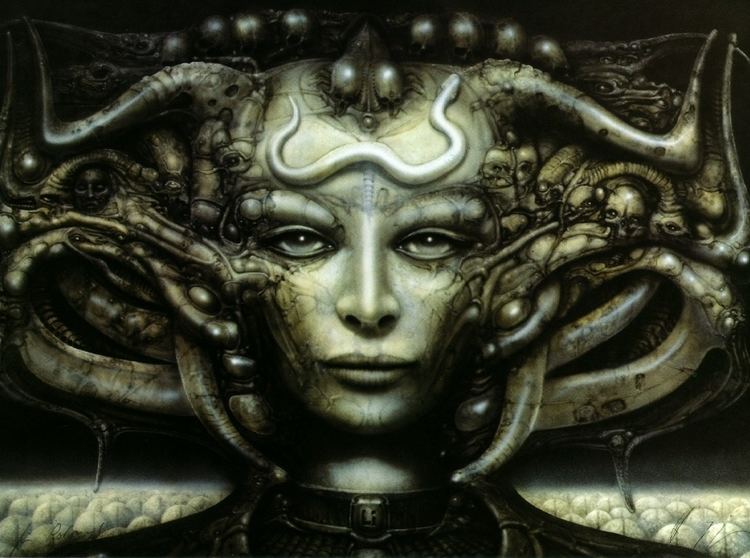
The Zurich-based artist was best known for airbrush images of humans and machines linked together in a cold 'biomechanical' relationship. Later he abandoned airbrush work for pastels, markers, and ink. He was part of the special effects team that won an Academy Award for design work on the film Alien. In Switzerland there are two theme bars that reflect his interior designs, and his work is on permanent display at the H.R. Giger Museum at Gruyères.
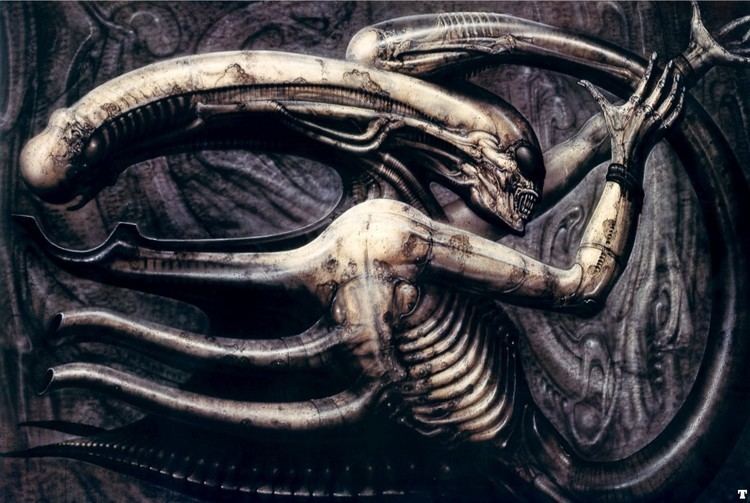
Bob Ross Special Guest H. R. Giger
Early life
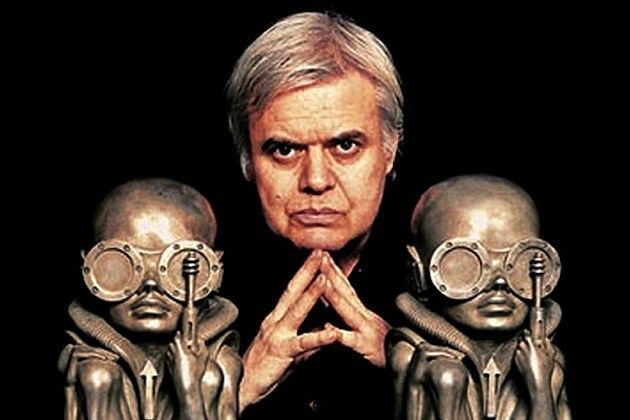
Giger was born in 1940 in Chur, capital city of Graubünden, the largest and easternmost Swiss canton. His father, a pharmacist, viewed art as a "breadless profession" and strongly encouraged him to enter pharmacy, Giger recalled. He moved to Zürich in 1962, where he studied architecture and industrial design at the School of Applied Arts until 1970.
Career
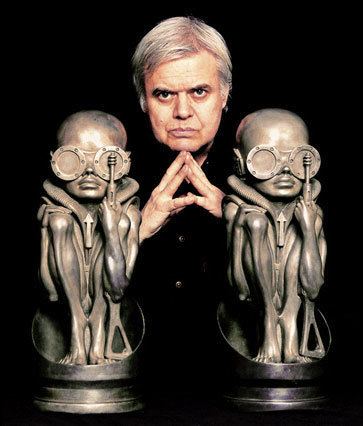
Giger's first success was when H. H. Kunz, co-owner of Switzerland's first poster publishing company, printed and distributed Giger's first posters, beginning in 1969.
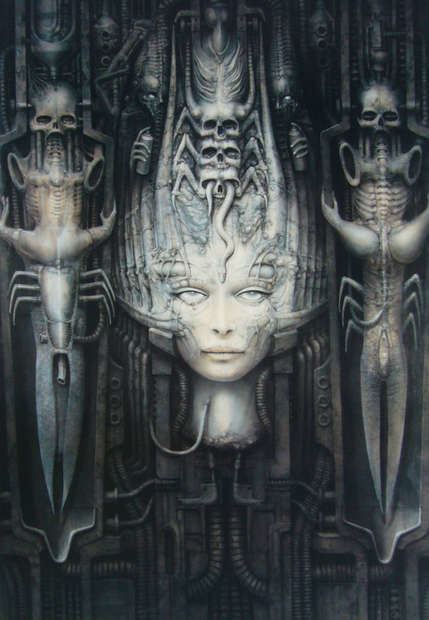
Giger's style and thematic execution were influential. He was part of the special effects team that won an Academy Award for Best Achievement in Visual Effects for their design work on the film Alien. His design for the Alien was inspired by his painting Necronom IV and earned him an Oscar in 1980. His books of paintings, particularly Necronomicon and Necronomicon II (1985) and the frequent appearance of his art in Omni magazine continued his rise to international prominence. Giger was admitted to the Science Fiction and Fantasy Hall of Fame in 2013. He is also well known for artwork on several music recording albums including Brain Salad Surgery by Emerson, Lake & Palmer and Deborah Harry's KooKoo.
In 1998 Giger acquired the Château St. Germain in Gruyères, Switzerland, and it now houses the H.R. Giger Museum, a permanent repository of his work.
Personal life
Giger had a relationship with Swiss actress Li Tobler until she committed suicide in 1975. Li's image appears in many of his paintings. He married Mia Bonzanigo in 1979; they divorced a year and a half later.
The artist lived and worked in Zürich with his second wife, Carmen Maria Scheifele Giger, who is the Director of the H.R. Giger Museum.
Death
On 12 May 2014, Giger died in a hospital in Zürich after having suffered injuries in a fall.
Recognition
In addition to his awards, Giger was recognized by a variety of festivals and institutions. On the one year anniversary of his death, the Museum of Arts and Design in New York City staged the series The Unseen Cinema of HR Giger in May 2015.
Dark Star: H. R. Giger's World, a biographical documentary by Belinda Sallin, debuted 27 September 2014 in Zurich, Switzerland.
Style
Giger started with small ink drawings before progressing to oil paintings. For most of his career, Giger had worked predominantly in airbrush, creating monochromatic canvasses depicting surreal, nightmarish dreamscapes. However, he then largely abandoned large airbrush works in favor of works with pastels, markers or ink.
Giger's most distinctive stylistic innovation was that of a representation of human bodies and machines in a cold, interconnected relationship, he described as "biomechanical". His main influences were painters Dado, Ernst Fuchs and Salvador Dalí. He met Salvador Dalí, to whom he was introduced by painter Robert Venosa. Giger was also influenced by the work of the sculptor Stanislas Szukalski, and by the painters Austin Osman Spare and Mati Klarwein. He was also a personal friend of Timothy Leary. Giger studied interior and industrial design at the School of Commercial Art in Zurich (from 1962 to 1965) and made his first paintings as a means of art therapy.
Other works
Giger directed a number of films, including Swiss Made (1968), Tagtraum (1973), Giger's Necronomicon (1975) and Giger's Alien (1979).
Giger created furniture designs, particularly the Harkonnen Capo Chair for a film of the novel Dune that was to be directed by Alejandro Jodorowsky. Many years later, David Lynch directed the film, using only rough concepts by Giger. Giger had wished to work with Lynch, as he stated in one of his books that Lynch's film Eraserhead was closer than even Giger's own films to realizing his vision.
Giger applied his biomechanical style to interior design. One "Giger Bar" appeared in Tokyo, but the realization of his designs was a great disappointment to him, since the Japanese organization behind the venture did not wait for his final designs, and instead used Giger's rough preliminary sketches. For that reason Giger disowned the Tokyo bar. The two Giger Bars in his native Switzerland, in Gruyères and Chur, were built under Giger's close supervision and they accurately reflect his original concepts. At The Limelight in Manhattan, Giger's artwork was licensed to decorate the VIP room, the uppermost chapel of the landmarked church, but it was never intended to be a permanent installation and bore no similarity to the bars in Switzerland. The arrangement was terminated after two years when the Limelight closed. As of 2009 only the two authentic Swiss Giger Bars remain.
Giger's art has greatly influenced tattooists and fetishists worldwide. Under a licensing deal Ibanez guitars released an H. R. Giger signature series: the Ibanez ICHRG2, an Ibanez Iceman, features "NY City VI", the Ibanez RGTHRG1 has "NY City XI" printed on it, the S Series SHRG1Z has a metal-coated engraving of "Biomechanical Matrix" on it, and a 4-string SRX bass, SRXHRG1, has "N.Y. City X" on it.
Giger is often referred to in popular culture, especially in science fiction and cyberpunk. William Gibson (who wrote an early script for Alien 3) seems particularly fascinated: A minor character in Virtual Light, Lowell, is described as having New York XXIV tattooed across his back, and in Idoru a secondary character, Yamazaki, describes the buildings of nanotech Japan as Giger-esque.
